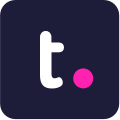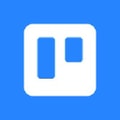

Unclaimed: Are are working at Airtable ?
Airtable Reviews & Product Details
Airtable is a powerful visual project management platform that synergizes data, workflows, and execution teams on a unified dashboard. Streamlining work streams, the platform provides a synced and up-to-date information database that can be accessed by all stakeholders across different departments. Customization is at the heart of Airtable, allowing teams to create personalized apps and a tailored interface allowing easy access to relevant information and giving clear sightlines to the next steps. While customization is a key benefit, it also offers ready-to-use and pre-loaded industry-agnostic templates while extensive integrations and expandability make it scalable and agile.


| Capabilities |
|
|---|---|
| Segment |
|
| Deployment | Cloud / SaaS / Web-Based, Mobile Android, Mobile iPad, Mobile iPhone |
| Support | 24/7 (Live rep), Chat, Email/Help Desk, FAQs/Forum, Knowledge Base, Phone Support |
| Training | Documentation |
| Languages | English |

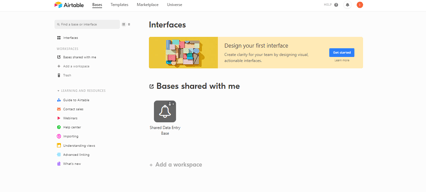
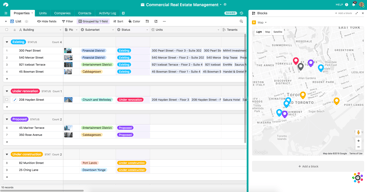
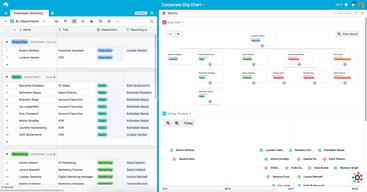
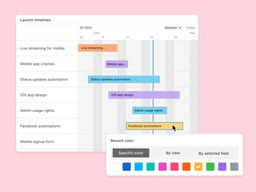
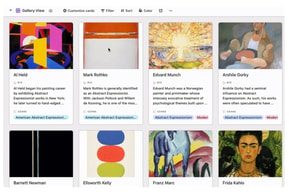
Compare Airtable with other popular tools in the same category.

The developers are constantly working to improve, there's a terrific community forum full of useful insight and suggestions, and it's easy to share a base with others. It's as easy to use as a spreadsheet, and so much more powerful. I find myself constantly making an empty base and using it just to make some simple data cleanup. On top of that, with the terrific formula support, internal automations, and tons of extensions there is almost no end to what you can accomplish with your data. They have a generous free tier that allows you to create an unlimited number of bases, invite a few friends, and have as many as 1200 records in each base. For home users, it's almost a no-brainer. I've tried some alternatives and haven't found one that's as easy to work with, or that has good formula support.
There are a few things that feel like limitations. One of my favorite database products is Filemaker, and its 'portal' feature is fantastic. I'd love to see something similar in Airtable. Yes, you can link tables, and perform lookups or rollups to pull data in from other sources (including syncing from other bases). It's just not the same.
Several. I've used it to merge data sources and clean up the results. Our company uses it to develop content. I've set up tables and bases to track and understand the permissions in cloud services, or keep track of all the cloud services we use (pricing, payment schedule, cost per user, etc). I have syncs set up to automatically show users in products. Set up a base to generate and post 'tip-of-the-day' in Slack. Another to calculate the usage in Make automation. Truly an all-around useful tool, and almost anything can be done without subscribing.
The sheer amount of data that you can compile, track, and analyze in Airtable is astounding. It has transformed just about every area of our business, from project management to production analysis to employee record-keeping and onboarding and so much more. With integrations from Zapier and Make, your source data is essentially unlimited. We would be piloting a ship sans a rudder without Airtable.
Some of the extensions are difficult to use and require some advanced knowledge. To my knowledge, it is not possible to overlay multiple sets of data on the built-in chart extension, and requires Vega-Lite to do that. I have neither the time nor desire to learn that, which is a bummer for something that is easily achievable on other platforms such as Google Sheets.
Airtable allows us to access vast amounts of company data, from a birds-eye view to granular, which helps inform our decision-making process in all departments across our company.
This is a versatile piece of software. I've used it for years: first, to track sales of household items when moving, then later for much more complex projects. A well-designed layout helps keep information clear and neat, whilst the functions for data are extremely powerful. I hardly scratch the surface of Airtable's capability, even with several complex bases on the go. Pros - Very powerful - Easy to use – with lots of information online to learn - Ability to capture information through forms which feed directly into a table - Multi-use - Pleasing design
Airtable is not a spreadsheet, so it takes some time to get your head around it. Once you’ve done this, it’s a helpful tool. A few frustrating niggles (such as not being able to have titles on two lines – this makes long titles with small data fields ridiculous on a spreadsheet) continue to persist. The next level up for Airtable is expensive (from the free version), but the free version does plenty.
Here are two scenarios we have used as a small charity. 1. Finances: expenses, claims, bank records Airtable has made life much easier for us with our summer project finances. It allows volunteers to claim expenses through a form which collects all relevant information about the expenses, bank details for repayment and allows an image to be uploaded. This feeds into a Base (document) which also tracks bank records and reimbursements. As a non-coder, this allowed us to build a financial system that fit our needs. A few clicks gave our treasurer access, and audit trails were visible – as well as easy analysis of expenditure and income. 2. Application tracking Every year we have dozens of applications for a summer project. These applicants need to be referenced, sorted, screened, and then accepted onto relevant teams and linked with host families who can cater to each applicant's needs during their time with us. A complex system which has been made simple with Airtable. Airtable links directly to our website through the API, and neatly pulls through a PDF application and any data we need for each applicant to enable us to sort. A separate table is built for hosts, and linking these tables is a doddle with Airtable. We no longer need to retrieve information from multiple courses, re-save updated information to Dropbox (for outside volunteers) and Onedrive (for staff), and keep archival records for the future. Now Airtable does all this, and each year one central Airtable document contains all we need – and all data is easily processed or deleted according to GDPR standards.
I've been using Airtable since May 2018 until I found another tool that could replace everything they offer. It's a very flexible tool, especially after they introduced extensions to write your own JS scripts, automation that takes over some of what I was doing with Zapier or Make, and now already the ability to create convenient interfaces. With interfaces, it will be much easier to transfer my whole team to Airtable.
In Airtable I don't have enough for 50,000 rows and the bigger the database the slower it works. The price per user per month is a bit high for my region. One suggestion would be to have different prices depending on the access level of each user.
I set up a complex system on Airtable where I keep my business accounts because I trust Airtable. The problem that Airtable solves for me is the clutter in which I keep my accounting records. Now I'm sure everything is safe and in order.
Airtable is like a filing cabinet full of tiny, helpful elves that look after all your business information and are ready to show it to you in whatever format you need at the drop of a hat. You can add information from all kinds of places (see a useful link, pop it in Airtable, need to save an email - pop it in Airtable)
A bit of a steep learning curve to really get the most from it but completely worth the effort. Populating data can also be a bit time consuming but this is not specific to Airtable, just getting any system set up right.
Airtable serves as the central data repository for all my business information. It makes responding to queries, knowing what's going on and finding information so much faster than it was when I was looking up information in separate systems.
The ease with which I can develop simple, fast and effective databases. In addition, the functionality of capturing data through a form. What sets Airtable apart from its competitors is the ease of use and pragmatism it allows when building databases, as well as its powerful automations.
I don't really have a strong dislike. I have not been able to fully identify the correct use of the apps, but that is a matter of me spending more time exploring their applications and uses
It has helped me spend more time on strategic issues and reduce time on operational processes that do not generate greater value.
I'm a freelance architect and have been looking for the right project management software for YEARS. Finally, a software friend recommended Airtable. I actually paid my friend to build my framework since he was so familiar with Airtable and it is AWESOME. I use it to manage my work flow, make sure I don't overbook myself, AND project my earnings. It's been a huge game changer for my business. It's saved me so much time.
It would have taken me a lonnnnnng time to build the framework myself. I'm glad I had my friend to help.
Managing my work load, project flow, and financial projections.
I've incorporated airtable into every research question I design, and it has been extremely useful for data entry and exploratory research. I like that it is customizable but at the same time very easy to use in terms of user interface. I can adapt it to the user's needs but also maintain control over the data entry process.
Some functionalities that are present in other spreadsheet systems are not present in airtable, but could be. Working with strings is particularly difficult. Downloading charts would also be highly beneficial.
Data entry, data management and exploratory data analysis. I don't have to design a separate MySQL database for every project and I don't have to do with makeshift excel solutions either.
Multiple users can work in the same field simultaneously. Very stable information platform. Great analytics with the free version. Works right out of the box. No need for an IT department.
App on Android is slow to sync to the rest of your information, on PC this has never been a problem.
Project Tracking between multiple locations with multiple people working in the data at the same time. We tried this with Microsoft products but it was clunky and difficult. Airtable worked right out of the box.
I can create almost any framework for task management, knowledge base, inventory handling, you name it. And I can make it quickly and conveniently.
One time I lost an entire database with track records of my allergy occurrences - it had a 3 or 4 years history. I still don't know how and why the database was removed. Since DB removal is irreversible, I can't restore it and see which actions led to it.
1. Prototyping. When I deal with a situation with lots of entities involved, I try to model everything in Airtable before anything else 2. Tracking things. I used to track my allergy occurrences and sickness of other kinds, spending and earnings, physical activity 3. Managing projects. I use three databases to manage products in my company.



